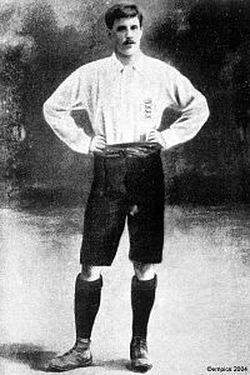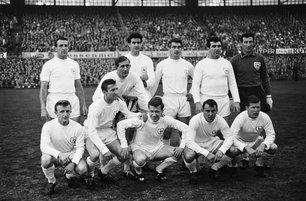 Arthur Rowe is the manager who led Tottenham Hotspur into the modern era, and in the process changed English football forever. His achievements are only just becoming fully recognised, partly because of the subsequent achievement of Bill Nicholson and the Double “team of the century”, and partly because of Rowe’s understated style. But Rowe’s influence on the club is immense, and arguably it was he who was the pivotal figure in shaking the English game out of its complacent insularity. A Tottenham lad through and through, Rowe was born literally a goal kick from White Hart Lane in 1906. He signed for Spurs as a 17-year-old after playing for nursery clubs Chesgunt and Northfleet United – another product of Peter McWilliam’s vision. He went on to establish himself in the first team. As a player, Rowe was a cultured centre half, always looking to play the ball rather than hoof it upfield. He was a student of McWilliam’s approach, and when he had to retire due to injury in 1939 there was little doubt he would go into management.
4 Comments
 The midfield maestro is as much a part of Tottenham Hotspur’s identity as the white shirt and the cockerel badge. One of the earliest exponents of the art of the playmaker at Spurs was Jimmy Seed, a player who had been written off after being gassed in the trenches of the First World War. Born in Consent in the north east of England, Seed grew up in the coastal community of Whitburn, leaving school to work down the local coal mine. He also played for Whitburn FC in the local league, where he was picked up as a 19-year-old by Sunderland after scoring 80 goals. He continued scoring for Sunderland reserves but his career was interrupted by the war and he signed up to fight. He was drafted to France where, in the last weeks of the war, he was gassed.  Tottenham Hotspur have always had players who can light up a pitch all on their own. Jimmy Dimmock could certainly do that. One of the finest players ever to turn out in a Lilywhite shirt, Dimmock’s story would be dismissed as an unlikely fantasy if it were presented as a movie script. But this story is true.  The latest in Martin Cloake’s series about some of the key figures who made the club what it is. Alexander ‘Sandy’ Brown is the original swashbuckling centre forward in the Tottenham Hotspur story, and another famous Scot. Signed from Portsmouth in 1900, where he had been top scorer as the south coast side finished runners- up to Spurs in the Southern League in 1899, he went on to score 96 goals in 113 appearances over two years. In the 1901 FA Cup run, he scored 15 goals, netting in every round.  Hoddle, Gazza, Klinsmann, King, Berbatov and Bale – there can be few, if any, Spurs fans unfamiliar with those names and what they achieved for the club. But what about the club’s heroes from further back in history. In this latest series, Martin Cloake selects some of the key figures who made the club what it is. In an age when football clubs are owned by multi-billionaires who often seem at least as interested in their own glorification as that of the clubs they lead, remembering the man who was the first president of Tottenham Hotspur Football Club is a reminder of the game’s more humble beginnings.  It’s often been said that Spurs are most successful when there is a Scotsman centrally involved, and over the years some of Scotland’s finest players have worn the famous lilywhite shirt. The first of Tottenham’s flying Scotsman was John Cameron. Born in Ayr, Cameron played for the famous Scottish amateur side Queens park before moving to Everton, where he played as a centre-forward before moving to the inside-forward’s slot. In 1898, Everton placed him on the transfer list, a move thought to have been influenced by Cameron’s activity as secretary of the newly-formed players’ union.  THE MEN WHO MADE SPURS In this latest series, Martin Cloake looks at some of the key figures who have made the club what it is. If ever a footballer epitomised the image of the English sporting gentleman, it was Vivian Woodward, one of the earliest exponents of the style of play that Spurs would come to be associated with. He was a popular figure, called “Sir” by his contemporaries, and refused to indulge in foul play or dubious tactics on the pitch. His place in Spurs history comes because he scored the club’s first league goal, and became the first Spurs player to be capped for England. Woodward was born in Kennington, south London and qualified as an architect. He started playing football for non-League Chelmsford City, and was soon noticed by the big clubs. In 1901 he was invited to play for Spurs reserves and within two years became the club’s first-choice centre forward.  The English FA Cup is the oldest and arguably most famous knockout competition in world football. First competed for in 1883, it had been dominated by clubs from the north of England, the stalwarts of the early professional game. In 1901, Tottenham Hotspur broke the northern stranglehold, establishing themselves as a serious force in football and also setting a record that is unlikely ever to be broken. For Spurs were the first, and still the only, non-league side to win the Cup.  After the club’s formation in 1882, Spurs quickly established a reputation for playing attacking, flowing football that excited the growing number of spectators who turned up at the newly-enclosed ground on Tottenham Marshes. But there were other reasons, too, why Spurs rapidly gained a loyal following. Football at the time was dominated by club’s from the country’s industrial powerhouses – Blackburn Rovers, Preston North End, Sheffield United, and Aston Villa from the Midlands industrial sprawl around Birmingham. Those clubs were also from the north of the country, their power fuelled by their ability to draw support from the vast industrial working class populations of those towns. Spurs, represented something different.  Having followed Spurs since 1970 at home and away, Martin Cloake knows the history and traditions of this great club. He is the author of several popular books about the club and, in a series of exclusive articles for India Spurs, he’ll be telling the story of just what makes Tottenham Hotspur the most unique club in world football Why the name Hotspur? It’s a proud boast that, in a world of Citys and Uniteds, there is only one Hotspur. But where does such a distinctive name come from? The answer can be found with the group of schoolboys who founded the club.
|
Features
Flying Down to Rio History of T.H.F.C. Tribute to Bill Nicholson Talking Tottenham Early Legends The Road to Turin International Connections Hotspur Towers Most Read Articles
The 100 Year War Interview with Marina Sirtis A Long Dark Shadow By Royal Appointment School Report: An Insight into the Younger Eric Dier Dear Jimmy All Change At Spurs Hotspur Towers History Of THFC: Part 1 Passage to India: Rohan Rickets Thanks For The Memories Our Tommy Carroll The AVB Files: Part1 The Lilywhites You The Jury The Hand Of Hugo Connection - Argentina Creating a Reputation One Hotspur Archives
August 2018
Categories
All
|


 RSS Feed
RSS Feed

